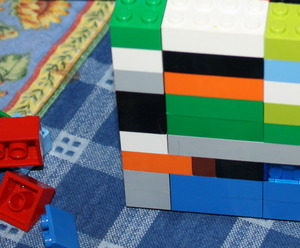Manipulatives are one example of critical learning centers in a preschool classroom. Like other play centers including housekeeping and dress up, manipulatives are not only fun but offer many opportunities for learning.
What are manipulatives?
Manipulatives are a category of learning toys that can be “manipulated” by little hands encouraging fine motor skills. Often the word is used interchangeably with blocks but can refer to an ever-widening group of toys that kids can build or create things from such as beading sets or magnetic building sets.
What are the learning benefits from blocks and manipulatives?
Blocks and many manipulatives are open-ended toys, which means that the possibilities for play are infinite. Being open-ended adds to their value as a learning toy. While the fine motor skills of playing with manipulatives are obviously inherent, manipulatives can address a variety of areas of learning development. Here are just a few simple examples.
Language:
Often more than one child can be playing in a block center whether they are playing parallel (simply beside one another) or interactively (working together).
“Look at my high tower!” a child may say or “Could you pass me a red block?” another may ask.
Cognitive:
Manipulatives can address several areas of cognitive concepts from colors, to counting to size.
A child may be a house from all red blocks with a green roof showing sorting skills.
Another child may be build a tower and count them as being eleven blocks tall showing measurement skills.
Yet another child may learn that putting large blocks on the top of small ones leads to a topple demonstrating science concepts and engineering skills.
Fine motor:
All aspects of manipulatives practice fine motor skills from picking up pieces to stacking, snapping together and even taking them apart. Little fingers are working hard and reinforcing those writing muscles.
Gross motor:
Not all manipulatives lead to gross motor play but large ones that require kids to stand, balance on their knees or reach to stack can.
Social and Emotional:
Social and emotional development can be encouraged in a variety of ways through manipulative play from sharing pieces to showing pride in a finished creation.
Reading:
How can manipulatives be related to pre-reading? Consider a set of colored wooden beads with strings and pattern cards for creating patterns. Creating patterns and putting things in order sets the pathways for putting letters in order to create words, words in order to create sentences and sentences in order to create paragraphs. It may seem like a far reach, but differientating (telling things apart) and sequencing (putting things together) are the first stops in the road to reading.
Another simple way to include reading in manipulative to play is label, label, label. A permanent block center should have a sign reading “blocks.” A plastic bin of other manipulatives from beads to linking rings should also be labeled along with a picture for pre-readers.
Now that we understand the importance of manipulatives for learning in the classroom, let’s look at a common mistake in creating manipulative centers and easy tips for correcting it.
Defining workspace is critical.
Mega blocks sliding across the floor all around the room is not only dangerous but also doesn’t encourage learning. For large manipulatives that will be played with on the floor, like a Mega stacking blocks or wooden blocks, a rug can be a helpful way to define space. If this doesn’t work for your preschool, a colored tape outline on the floor can visually say, “This is the block area.” There can be reasons in a daycare that neither a rug or tape is the floor is a good idea, but teachers can still define space using small cones or something similar to show the learners that this is the block area.
Likewise for smaller manipulatives from Lego’s, Lincoln Logs, Magnetics or Crazy Creatures with gears, defining space of a table is also important. Trays with an edge can help keep pieces off of the floor but even a spread of old newsprint can define space and help students see that “this is my area to work and play.”
*Remember, scattered toys are dangerous to those walking, lead to pieces getting lost, don’t encourage learning and make clean up more challenging.
*A defined play area encourages play and learning, helps kids learn to be organized and take care of toys, and makes clean up easier.
Manipulatives are not only fun toys but important learning tools in a preschool classroom or at home. Offering a variety of manipulatives and helping kids keep them organized adds to the learning and the fun.
You can find more helpful tips here from this Featured Yahoo! Lifestyle Contributor in The Importance of Preschool Centers: Housekeeping.
